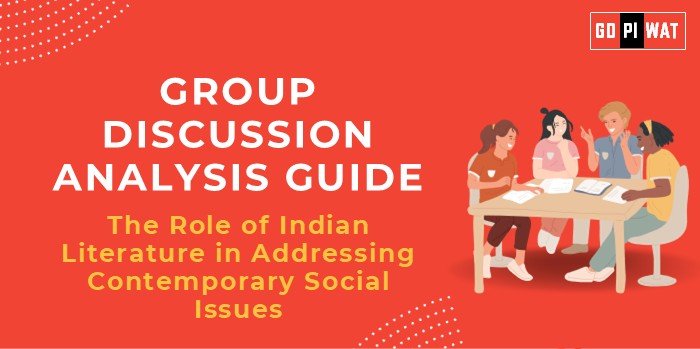📚 Group Discussion (GD) Analysis Guide
🖋️ Topic: The Role of Indian Literature in Addressing Contemporary Social Issues
🌟 Introduction to the Topic
Opening Context: “Indian literature, spanning centuries, has been a mirror to society, reflecting its complexities and championing change. In today’s era, literature serves as a profound medium to tackle pressing social issues.”
Topic Background: Indian literature, from ancient scriptures like the Vedas to modern-day novels, has influenced societal thought and behavior. In the contemporary context, it delves into issues such as gender equality, caste discrimination, environmental sustainability, and more.
📊 Quick Facts and Key Statistics
- 📖 India’s Literary Heritage: Over 22 officially recognized languages enrich its literary diversity.
- 📈 Publishing Industry Growth: India ranks as the sixth-largest book market globally, reflecting the relevance of literature in society.
- 🏆 Awards and Recognition: The Jnanpith and Sahitya Akademi Awards highlight impactful contributions.
- 🎥 Adaptations: 50+ literary works adapted into socially relevant films in the past decade.
👥 Stakeholders and Their Roles
- ✍️ Authors and Poets: Voice societal concerns and spark dialogue.
- 📚 Publishers and Media: Disseminate impactful works to wider audiences.
- 👩🏫 Readers and Academicians: Interpret and discuss themes, fostering awareness.
- 🏛️ Government and NGOs: Promote literature through grants and awards to encourage meaningful discourse.
✨ Achievements and Challenges
🌟 Achievements:
- 💡 Encouraged dialogue on caste through Dalit literature (e.g., “Joothan” by Omprakash Valmiki).
- 🎤 Amplified women’s voices through feminist narratives (e.g., works by Kamala Das).
- 🌍 Tackled environmental issues via literary activism (e.g., “The Hungry Tide” by Amitav Ghosh).
⚠️ Challenges:
- 🌐 Linguistic barriers limiting cross-regional reach.
- ⚖️ Censorship and political interference.
- 🔍 Underrepresentation of marginalized voices.
Global Comparisons: Similar to the Harlem Renaissance in the U.S., contemporary Indian literature is a platform for the underrepresented.
📋 Structured Arguments for Discussion
- Supporting Stance: “Indian literature uniquely addresses societal challenges by evoking empathy and critical thinking among readers.”
- Opposing Stance: “Despite its potential, Indian literature remains inaccessible to a significant portion of society due to linguistic and educational barriers.”
- Balanced Perspective: “While Indian literature is impactful in raising awareness, its accessibility and representation need improvement.”
💡 Effective Discussion Approaches
- Opening Approaches:
- 📜 Start with a quote: “Literature is the mirror of society.”
- 📚 Cite a case study: “The impact of ‘Godaan’ on rural socio-economic discussions.”
- Counter-Argument Handling:
- Acknowledge limitations but cite growth in translation and regional literature markets.
- Emphasize evolving publishing technologies for accessibility.
🔍 Strategic Analysis of Strengths and Weaknesses
- Strengths: Rich diversity, historical depth, global recognition.
- Weaknesses: Limited outreach, censorship issues.
- Opportunities: Digital platforms, increased translations.
- Threats: Political interference, declining reading habits.
🎓 Connecting with B-School Applications
- Real-World Applications: Themes from literature can inspire case studies in diversity management or CSR projects.
- Sample Interview Questions:
- 📘 “How can Indian literature inspire corporate social responsibility initiatives?”
- 📗 “Discuss the role of feminist literature in shaping leadership styles.”
- Insights for Students: Engage with themes to understand societal undercurrents affecting business environments.


